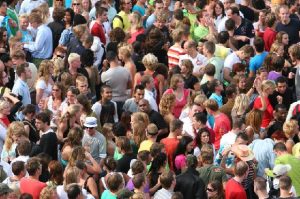 Crowd counting is a tough gig for those who want to do it right but when turnout implies clout, then then it gives people ample opportunity and motivation to exaggerate the count. As an example a crowd gathered in Hong Kong to attend a vigil. It just so happened to be the 22nd anniversary of the Tienanmen Square massacre where hundreds of people died. In some stories, 77,000 people turned up and in others, that figure was closer to 150,000.
Crowd counting is a tough gig for those who want to do it right but when turnout implies clout, then then it gives people ample opportunity and motivation to exaggerate the count. As an example a crowd gathered in Hong Kong to attend a vigil. It just so happened to be the 22nd anniversary of the Tienanmen Square massacre where hundreds of people died. In some stories, 77,000 people turned up and in others, that figure was closer to 150,000.
So why the disparity?
The first figure (77,000) is a police statement and the second larger figure (150,000) was reported by the event organisers. To see which figures were correct two professors took it upon themselves to run some numbers. They deduced that to fit 150,000 people into the designated space people would have to cram together at a rate of 4 people per square metre. That is ‘mosh-pit’ density and therefore unlikely without having major safety implications.
The problem is that counting large numbers of anything is difficult at the best of times. If for example you had to count a jar of jelly beans on 3 separate occasions, it’s highly probable that you’d come up with a different number every time. Now imagine if the items (read people) you are trying to count are continually moving, eg, stooping down to tie shoelaces, or moving about to music. It’s easy to see just how difficult the task in hand actually is.
So the question is…how do you accurately count crowds in large numbers, particularly at festivals or events? The good news is that it can be done if you apply a particular formula correctly. What’s more, by doing so it’s possible to estimate the crowd accurately to within a few tens of thousand. Let’s take a closer look how…
In the 1960’s Herbert Jacobsen a Journalism Professor at Berkeley University could see students gathered on the plaza below to demonstrate against the Vietnam War. Fortunately for him the plaza’s concrete was in an even grid format. So he counted the amount of students in a selection of gridded squares and then multiplied by the total amount of squares the plaza had. From this he derived a very basic density rule which is as follows…
-
Light density – 1 person per 1.5 square metre
-
Medium density – 1 person to 1 square metre
-
Heavy density 1 person per 0.5 square metre
-
Mosh-pit density – 1 person to every 0.25 square metres
The problem
As suggested, this form of crowd counting is rudimentary at best and unfortunately has its flaws. For example, crowds are never uniform, they tend to clump in certain spaces and thin out in others.
That said there is a ‘get-a-round‘. Consider for example where people may be standing and where they’re more likely to congregate. This is a necessity for crowd control planning. For example, if it’s hot, chances are that more people will gather in shady areas, eg. under trees etc. Alternatively at a music event, the stage area or jumbo screens are also going to be popular standing areas, whereas areas around the loudspeakers may be less dense. While taking this into consideration, you’ll need some aerial photographs. Modern-day drones can achieve this easily. Next, lay a rough grid system over the top and using the light, medium, heavy density formulae listed above, it’s possible to estimate the numbers in each grid. Finally add the numbers in each grid up to give you the total estimated crowd.
While it’s not a perfect science, you’ll be surprised at how accurate this method can be and it sure beats counting heads one by one!
At MA Security, while we can’t promise to count your crowd for you, we can promise to properly control them. Having acted as security for some of the largest music festivals and events in Queensland, we like to think we know what we’re talking about. So if you’re planning an event and need security, you know who to call! Contact us today on 1300 020 406 for further information.


